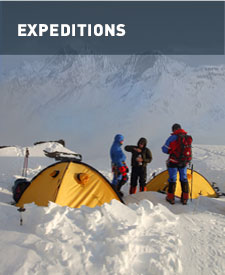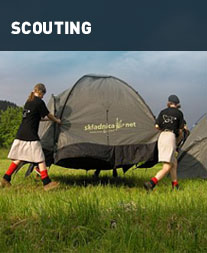The tent is waterproof, but ....- a few words about condensation.
It didn’t rain at night (or it was a short drizzle), but in the morning you discover that the internal surface of the flysheet is wet... This is normal and you shouldn’t worry that your tent is leaking – the cause is water vapour condensation. It occurs in every tent. This phenomenon depends mainly on external conditions (moisture in the air, soil evaporation, temperature difference) and internal environment of the tent (the number of people inside, ventilation efficiency). Therefore you should ensure the best ventilation inside your tent e.g. by opening the vents or half/opening the entrance at night. We recommend tents with two entrances as they provide the best ventilation available – by partial opening of two entrances you would get proper air circulation and optimal ventilation conditions during sleep. A good idea is to put a camping tarpaulin under your tent - it reduces the condensation of vapour from the ground. In winter conditions we also advise to additionally cover your sleeping bag e.g. with a jacket, especially in its lower part.
About water resistance - chasing numbers...
Many tent users mistakenly assess the quality of the tent basing only on its water resistance, but we suggest taking into account the following facts:
1. Different fabric manufacturers apply different methods of measuring waterproofness, (according to some measurements our tropics flysheets have higher waterproofness than we declare)
2. The watertight integrity of the flysheet depends not only on the quality of the fabric it is made of, also on properly taped seams. Therefore, we suggest customers to always check the quality of taping. For taping tent seams Marabut uses the latest technology based on thermo-adhesive tape applied on the seams
According to our long-term experience – water-resistance at the level of 3000 mm is fully sufficient to withstand the strongest downpour.
The floor is solid, but still there are tiny holes in it ...- the price of lightweight solutions
Tents produced 20-30 ago had really indestructible floors, which were often made of strong rubberised materials. Unfortunately - these tents weighed several kilograms. Modern tents tend to be lighter and there is no place for a heavy floor. Every tent user must pay attention to the features of the surface on which the tent is put up. Any movement of the tent, especially on rocky ground may easily damage the floor. If you expect putting up your tent on the ground that could damage the floor - we recommend providing an additional protection – buy a tarpaulin and place it under the tent.
The flysheet is very strong, but ....- a few words about UV radiation.
It is not true that modern tents have everlasting flysheets. Probably tents produced 30-40 years ago were even more durable. However, their weight ranged from 15 to 20 kg, whereas nowadays it is only 3-5 kg. Lightweight polyester flysheets have also their disadvantages. After prolonged use they lose their colour and tear resistance. The main damaging factor for tents is UV radiation. This radiation is particularly strong at high altitudes. If possible, try to put up your tent in shaded places, especially when you are planning a long camping. Marabut tents have their flysheets protected by UV filter. But this solution does not guarantee 100% resistance to the damaging effects of sun rays.
Aluminium poles are robust, but ..... why tent poles break.
Aluminium alloys used for production modern tent poles are very strong and flexible. Unfortunately it is not true, that they cannot be broken. Sometimes they crack due to mechanical damage. We have also noticed that in some tents poles may bend throughout their lifetime due to the nature of their operation. This should not be a reason for concern.
To avoid unpleasant surprises resulting for cracked or broken tent poles, we recommend buying our repair tube for aluminium poles – or on of our repair kits for fibreglass poles.
Why we use polyester for our flysheets?
Generally, modern tent manufacturers, have a choice of two fabric types for flysheets: nylon or polyester. Both of them have their advantages and shortcomings. Taking them into account - we have decided to use polyester. Why?
1. This material has almost zero water absorption, which is why after the rain polyester flysheets do not “sag” as those made of nylon. This make the outer shell of the tent always properly tense and there is no contact between wet flysheet and not come into contact with the inner canopy.
2. Polyester has higher UV resistance, which makes the operational lifetime of the flysheets longer.
3. The polyester fabric that we use has three layers of waterproof PU coating. This ensures full integration of the sealing tape with the flysheet, making the seams of our tents fully leak-proof for many years.
The main disadvantage of polyester fabric when compared to nylon are weaker fibres. Therefore, in order to maintain similar strength properties, polyester fabrics have a higher basis weight than those made of nylon, by approx. 30%. This make polyester tents slightly heavier than nylon tents.
Taking all the above features into account, we have decided that polyester would be the best choice when it comes to the balance between the weight and operational lifetime of our tents. We want the customers to enjoy our tents for long years, not only a few seasons.
Why we use polyethylene for our floors ?
In the pursuit of lightweight solutions, many manufacturers use light, nylon floors. They are indeed very light, but unfortunately not so perfect when it comes to water resistance and mechanical strength, often requiring additional protection. Costumers, checking tent parameters, tend to forget about strong floor. Therefore their backpacks will be additionally burdened by an extra floor protection (approximately 0.3 - 0.5 kg). We suggest remembering about this important feature instead of paying attention only to the catalogue weight of a tent.
Marabut makes floors of a high density polyethylene, laminated on both sides. This fabric is highly water resistant and very resistant to tearing (it is important when camping on stony ground which is a standard case in mountains).
Connection between the flysheet and the inner canopy
When choosing a tent, pay attention to the technique used for connecting the flysheet and the inner canopy. In most of the tents the flysheet is put over the inner canopy and both of them are connected by cords or Velcro tape. In really bad weather conditions, this connection is hard to make and during heavy rains almost impossible.
Marabut tents have their flysheet integrated with the inner canopy, but this connection is detachable. Tent poles are inserted into pole sleeves making the setup process quick and easy. The inner canopy is always dry even when the tent is set up in the rain. This solution significantly shortens and facilitates the set-up process. According to our testers, the tents with externally mounted poles perform better during strong winds.












